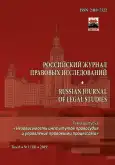Central clearing of OTC derivatives in the EU
- Authors: Kriger A.M.1
-
Affiliations:
- MGIMO University
- Issue: Vol 6, No 1 (2019)
- Pages: 116-125
- Section: Articles
- URL: https://journals.rcsi.science/2410-7522/article/view/18479
- DOI: https://doi.org/10.17816/RJLS18479
- ID: 18479
Cite item
Full Text
Abstract
This paper aims to determine the general rules and particularities of central clearing of OTC derivative contracts in the EU.
The reform of OTC derivatives market has become a regulatory response to the Global financial crisis which has negatively affected the major economies of the West. According to the G20 obligations, one of the methods applied to eliminate consequences of the crisis and to prevent the same situations on financial markets was introduction of obligatory central clearing of OTC derivatives transactions. This obligation was implemented into the ‘EMIR’ Regulation № 648/2012/EU, and was afterwards developed in delegated regulations and regulatory technical standards in the EU.
Central clearing was invented in XIX century, but it hasn’t been widely used until end XX century. Central clearing is applied for risk mitigation in financial transactions. There are various models of central clearing. The most popular of them are novation, non-defined legal construction and agency model. Central counterparties, clearing members and their clients are empowered to render clearing services in the EU.
According to the new regulation, all OTC derivatives market participants are divided into financial and non-financial counterparties. Level of the activity determines whether a non-financial counterparty has to centrally clear OTC derivatives contracts.
European Securities and Markets Authority (ESMA) carries out supervision of central counterparties, as well as establishes financial and administrative requirements for them. The paper examines supranational aspects of OTC derivatives clearing, as well as practical issues depicted by examples of major EU central counterparties.
Keywords
Full Text
##article.viewOnOriginalSite##About the authors
Anzhelika M. Kriger
MGIMO University
Author for correspondence.
Email: Angelica.kriger@mail.ru
LLM, PhD Candidate
Russian Federation, MoscowReferences
- Касьянов Р. А. Эволюция правовых основ Европейского союза в области регулирования рынков финансовых инструментов, 1993 - 2015 гг. // Законы России. Опыт. Анализ. Практика. 2015. № 11. С. 76-79.
- Уткин В. С. Сущность деятельности и роль центральных контрагентов на современном финансовом рынке // Финансы и кредит. 2009. № 40(376). [Электронный ресурс] URL: https://cyberleninka.ru/article/n/suschnost-deyatelnosti-i-rol-tsentralnyh-kontragentov-na-sovremennom-finansovom-rynke (дата обращения: 03.04.2018).
- Braithwaite J. The dilemma of client clearing in the OTC derivatives markets // European Business Organization Law Review. 2016. ISSN 1566-7529 [Электронный ресурс] http://eprints.lse.ac.uk/64476/1/Braithwaite_Dilemma%20of%20client%20clearing_2016.pdf (дата обращения: 11.05.2018).
- Bryan G. The Law of the Clearing Houses // Virginia Law Review. 1914-1915.
- Cecchetti S. G., Gyntelberg J., Hollanders M. Central Counterparties for Over-the-Counter Derivatives // BIS Quarterly Review. September 2009. [Электронный ресурс] https://www.bis.org/publ/qtrpdf/r_qt0909f.pdf (дата обращения: 06.04.2018).
- Chamorro-Courtland C. Central Counterparties and the New Transnational Lex Mercatoria // FSU Business Review. Vol. 10. 2011. P. 57-117.
- Garslian L. Towards a Universal Model Regulatory Framework for Derivatives: Post-Crisis Conclusions from the United States and the European Union // University of Pennsylvania Journal of International Law. Vol. 37. Issue 3. 2016. P. 941-1026.
- Gobbo G. MIFiD’s Systematic Internalisation: the Efficiency Debate and the Future of the European Financial Markets // European Business and Law Review. 2009. Issue 1. 20. P. 63-69.
- Henry D. Clarifying and Settling Access to Clearing and Settlement in the EU // European Business and Law Journal. Vol. 17. Issue 4. 2006. P. 1-20.
- Ho J. How Will Emir Affect Corporates? // International Financial Law Review. Vol. 46. April 2013. P. 48-50.
- Lynch T. E. Coming Up Short: The United States’ Second-Best Strategies for Corralling Purely Speculative Derivatives // Cordazo Law Review. Vol. 36. 2014-2015. P. 545-624.
- Peirce H. Derivatives Clearinghouses: Clearing the Way for Failure // Cleveland State Law Review. Vol. 64. 2016. P. 589-660.
- Smyth W. The New York Clearing House // The Banking Law Journal. 1891. P. 101.
- Szpringer M., Szpringer W. Law and Economics of Central Counterparties (CCP) - Selected Issues of Regulation and Competition Concerning Financial Market Infrastructure // European Business and Law Journal. 2016. Vol. 27. Issue 5. P. 587-603.
Supplementary files







